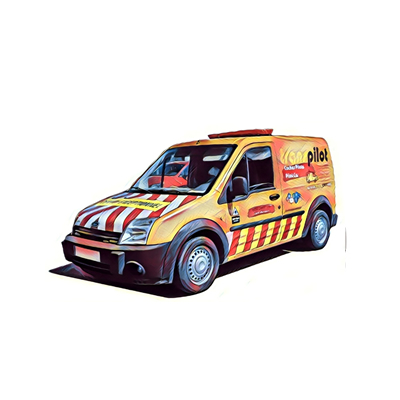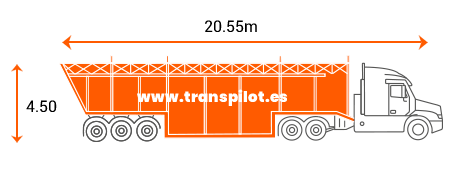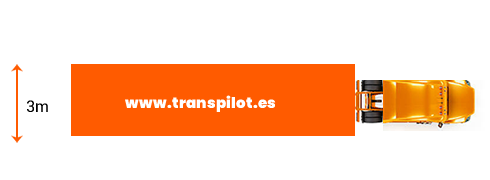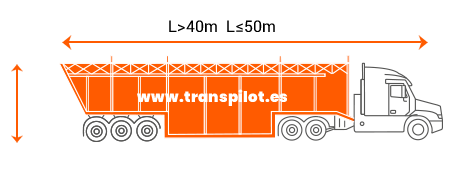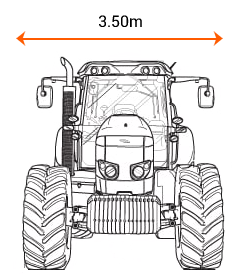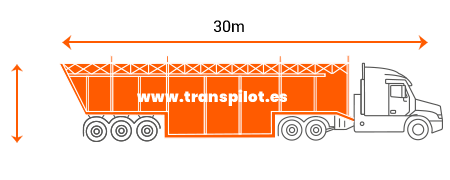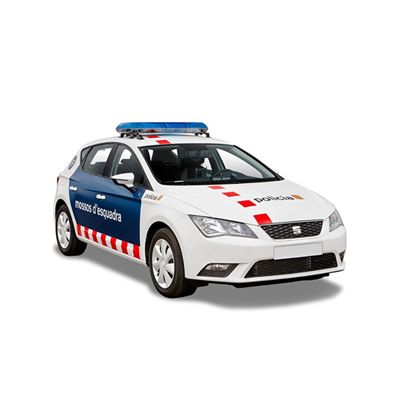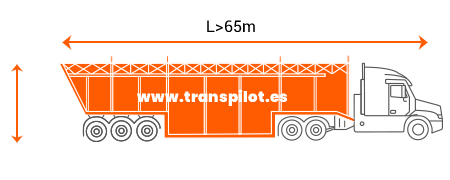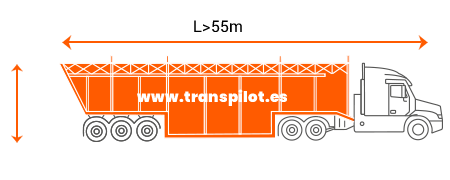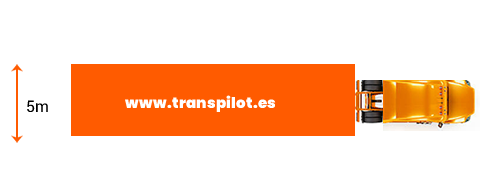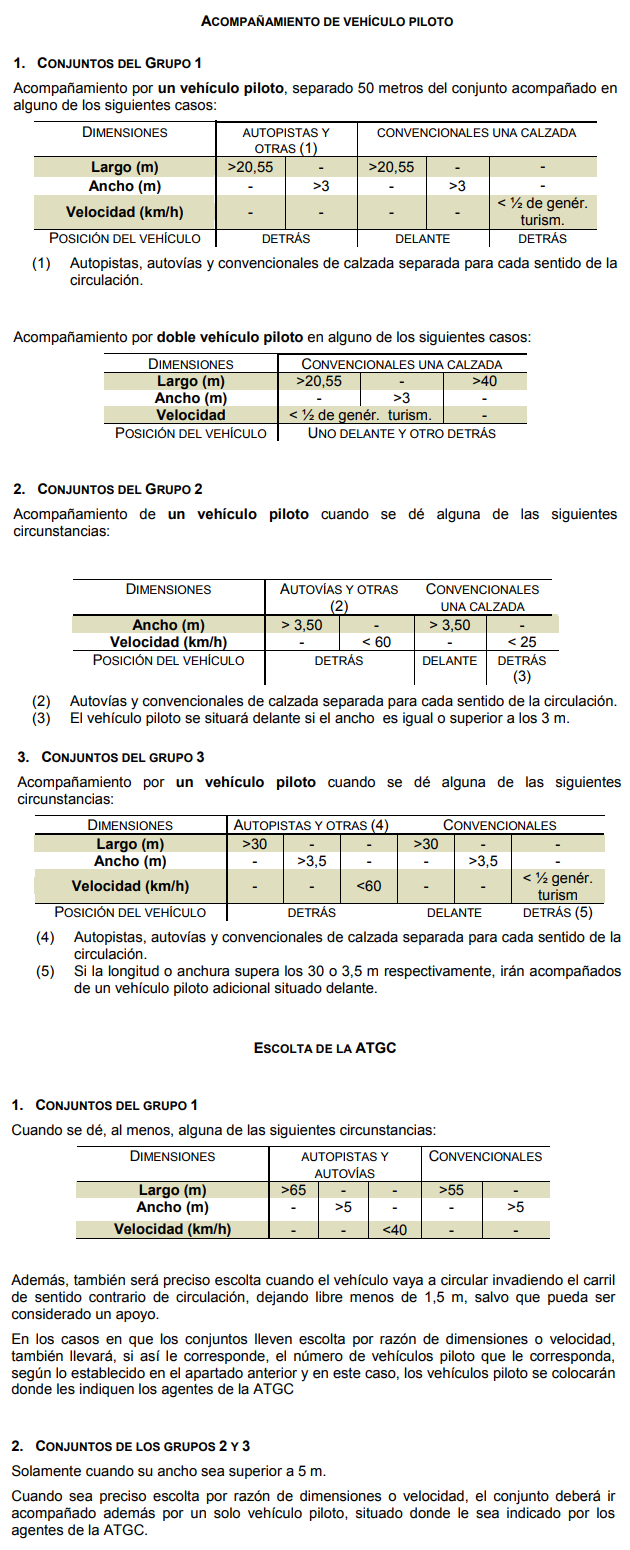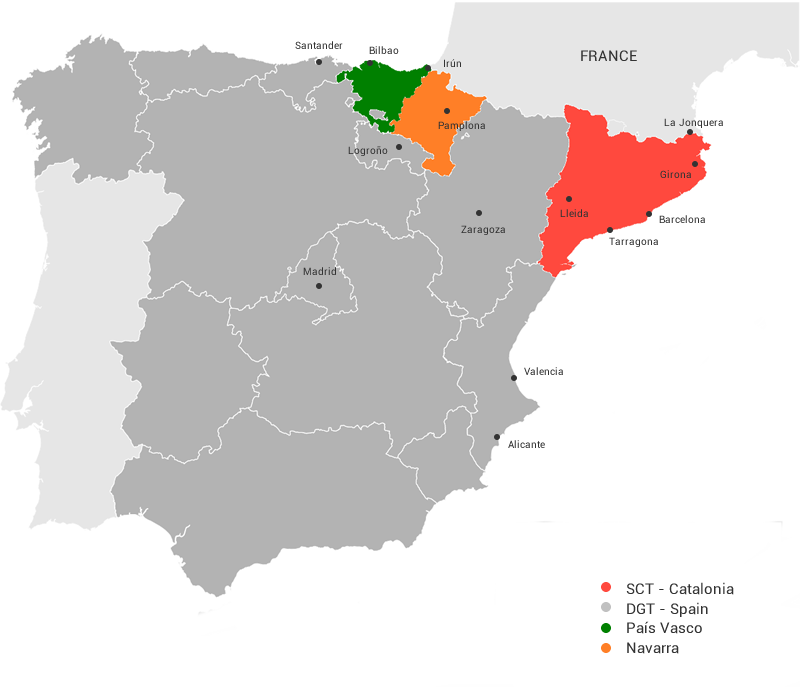1.2. Two pilot car on highways.
1.3 Two pilot cars on conventional roads.
Group 2 -Special agricultural vehicles and combinations thereof which, by reason of their construction, permanently exceed the maximum masses or maximum dimensions./div>
2.1 By dimensions
They may travel on motorways, even if they do not reach a speed of 60 km/h on level ground, when there is no alternative route or suitable service road.
2.2 By speed
If the speed of movement is less than half the generic speed allowed on the road, it will be located behind at said minimum distance.
Group 3 - Special vehicles and their assemblies for works and services which, by construction, permanently exceed the maximum masses or dimensions.
3.1 By dimensions: when the width exceeds 3.50 meters, or the length exceeds 30 meters.
3.2 By speed: If the speed of movement is less than half the generic speed allowed on the road, it will be located behind at said minimum distance.
Group 4 - By weight
- When its weight exceeds that established in the generic license, it shall require the accompaniment of a pilot car.
A pilot car in the rear on highways and a pilot car in the front on conventional roads.
2.- Police escort + pilot car
Escort of the police when the following dimensions are exceeded:
- Length 40.00m
- Width 5.00m
The holder shall inform, at least 72 hours in advance, the traffic police in the province of departure of the place, time and date of the start of each of the authorized journeys, indicating the license plate number of the vehicle or vehicles making the journey and then enclosing a copy of the authorization.
2.1 On highways police escort + 1 pilot car.
2.2 On conventional roads police escort + 2 pilot car.
2.3 On highways or conventional roads police escort + 1 pilot car.
2.4 On conventional road police escort + 2 pilot car.
2.5 On Highways police escort + 1 pilot car.
2.6 On highways police escort + 2 pilot car..
When the speed is lower than 40Km/h, on highways or freeways.
2.7 There are variations in Pais Vasco, consult the BOE.
3.- summary of points 1, 2
4.- Traffic conditions for groups 1, 2, 3
The pilot car will keep and maintain a minimum separation of 50 m with the vehicle that precedes it and will allow and facilitate the overtaking of faster moving vehicles, and will stop if necessary, In no case should it force drivers of other vehicles to abruptly modify their speed or trajectory.
Stops and parking will be made off the road and the shoulder.
The pilot vehicle is authorized to use the V-2 signal while providing the service, which shall be visible both to the front and to the rear and shall be switched off at the end of the service
It should be possible to establish communications by radio and by telephone in a language known to both parties between the personnel of the pilot vehicle and that of the cabin of the special vehicle or in a special transport regime.
As well as the signalling devices determined by the General Vehicle Regulations for the category of vehicle in question, special vehicles and vehicles under special transport regime, shall have V-2 light signals distributed in such a way that the outline of the cross section of the vehicles is perfectly delimited, on their front and rear fronts, as well as V-4, V-5 (optional of V-4), V-6, V-16, V-20 signals and those contemplated in article 15.6 and 7 of the General Traffic Regulations, when applicable. They will also permanently use the crossing lighting.
Traffic restrictions shall be always complied with, especially those that are signposted on the road or those indicated by the traffic control officers..
Traffic must be suspended leaving the traffic platform, when there are adverse atmospheric phenomena that pose a risk to traffic, or when there is no visibility of at least 150 m, both forwards and backwards.
The owner of the vehicle must make sure, even by walking the route prior to the completion of each trip, that there are no physical limitations or obstacles that would impede the journey.
Special vehicles or vehicles travelling under a special transport regime whose width exceeds five metres must be accompanied by traffic control officers. At least 72 hours in advance, the holder must inform the traffic police in the province of departure of the place, time and date of the start of each authorized journey, indicating the license plate of the vehicle or vehicles making the journey and enclosing a copy of the authorisation. The same notice shall also be sent to the body designated to receive it by the road owner.
4.1.- SPEEDS
a) Vehicle with generic authorization: the maximum allowed driving speed shall be 70 km/h. The more restrictive limitations appearing on vehicle's the ITV card shall prevail over these limitations.
b) Vehicle with specific authorization: the maximum speed allowed shall be 60 km/h. The most restrictive limitations appearing on the vehicle's ITV card shall prevail over these limitations
c) Vehicle with exceptional authorization: the maximum permitted speed will be that set out in the authorization, and in no case will it exceed 60 km/h. The most restrictive limitations appearing on the vehicle's ITV card shall prevail over these limitations.
4.2.- RUNNING HOURS
- Running hours: any vehicle operating under a special transport regime with a generic or specific authorization may operate both day and night; however, in the case of exceptional transport, it may be allowed to operate between sunset and sunrise when this is stated in the authorization issued.
-
They may not circulate on Sundays and national public holidays (public holidays in all the Autonomous Communities) and regional public holidays, from eight o'clock to twenty-four o'clock within the corresponding national or Autonomous Community district. Neither may they circulate on the eve of public holidays, except those which fall on a Saturday, on national public holidays, from 13:00 to 24:00 (this last limitation includes Wednesday 1 April, the eve of Thursday 2 April, in the Autonomous Communities where this day is a public holiday).

In addition, on weekdays in both directions in Madrid from 7h to 10h and from 18h to 21h (A-1 del km 11,8 to 50; A-2 from km 10,8 to 38; A- del km 7 to 40; A-4 del km 6,7 to 30; A-42 from km 6,2 to 27,5; A-5 from km 11,2 to 35; A-6 from km 6,8 to 39,5; M-607 from km 9,2 to 39,4; M-40 from km 0 to 61,3; M-45 from km 0 to 31; M-50 from km 0 to 84,5; M-501 from km 0 to 21,7; M-505 from km 0 to 29,5 y M-506 from km 0 to 53) and in Sevilla in SE-30 from km 10 to 12.
5.- Sanctions
Circular con el vehículo reseñado incumpliendo las condiciones establecidas en la autorización complementaria (detallar sucintamente la condición incumplida) Reducción de visibilidad por condiciones meteorológicas, visibilidad inferior a 150 metros por la parte delantera o trasera del vehículo · 450€
Según escrito de la DGT. de fecha 26/11/04, que se transcribe. Actualmente es posible circular con un vehículo o transporte especial amparado por una, dos o más autorizaciones complementarias de circulación para realizar un itinerario concreto. El origen y destino del viaje puede que no coincidan con lo establecido en la o las autorizaciones que se emplean, pero lo importante es verificar que en el momento de circulación del transporte o vehículo especial el titular de la misma este amparado por una autorización y se dé cumplimiento a lo establecido en la misma. NO DENUNCIAR POR ESTAR FUERA DEL ITINERARIO.
Según escrito de la DGT. de fecha 26/10/04, en relación de la posibilidad de que un taxi pude realizar funciones de vehículo piloto en un transporte especial le participo lo siguiente: El reglamento General de vehículos define el taxi como turismo destinado al servicio público de viajeros y provisto de aparato taxímetro o no. El citado RGV. impone además a los taxis la obligación de ir dotados de determinas luces y señales especificas, de forma permanente. Por otra parte el Art. 66.1.a) de la Ley 38/92 de Impuestos especiales establece que los taxis estén exentos del impuesto especial sobre determinados medios de transporte ello, en base al servicio que se destinan. Por todo ello, y considerando además que los vehículos piloto de acompañamiento de transportes especiales deben, conforme al Anexo XI del RGV., llevar instalados la señal V-2, previa acreditación ante la Jefatura Provincial de Tráfico del servicio a que se destinan, que en el caso del taxi, ESTA SUBDIRECCIÓN GENERAL ESTIMA QUE UN TAXI NO DEBE SER AUTORIZADO PARA LA REALIZACIÓN DE SERVICIOS DE VEHÍCULO PILOTO DE ACOMPAÑAMIENTO A UN TRANSPORTE ESPECIAL.
Circular sin la autorización complementaría correspondiente con el vehículo reseñado cuyas masas o dimensiones, incluida la carga indivisible, exceden de los límites reglamentarios · 500€
6.- Time restrictions
6.1 - National holidays
7.- Sketh País Vasco


Real Decreto 1428/2003 de 21 de noviembre, por el que se aprueba el Reglamento General de Circulación para la aplicación y desarrollo del texto articulado de la Ley sobre tráfico, circulación de vehículos a motor y seguridad vial, aprobado por el Real Decreto Legislativo 339/1990, de 2 de marzo.
Si observas algún fallo o falta de actualización puedes contactar para proceder a su corrección.
Normativa Coches Piloto para transportes especiales en España
Acompañamiento Vehiculo Piloto
¿Cuando hace falta coche Piloto?
